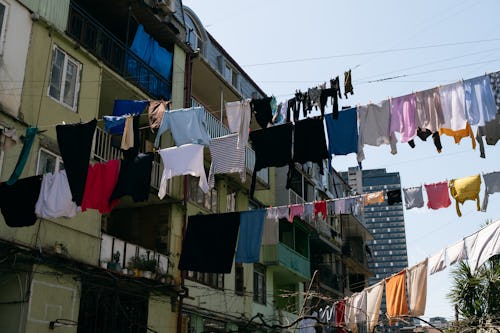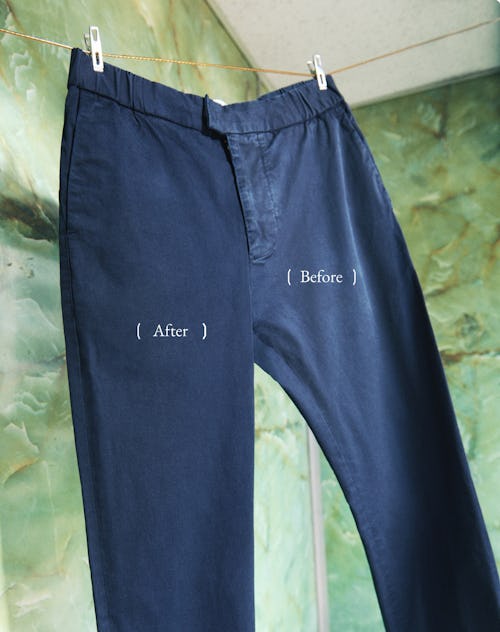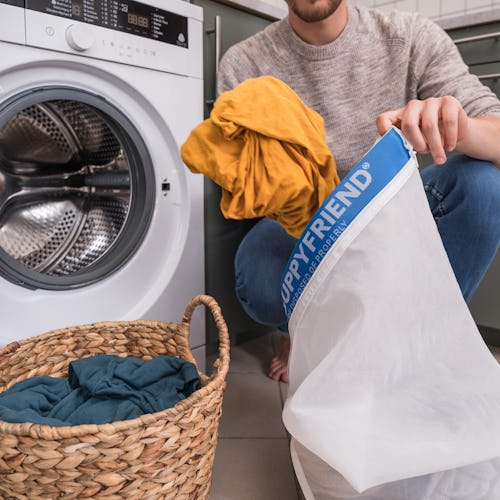
Fashion sustainability is becoming big business. As Copenhagen Fashion Week, a global hub for sustainable fashion, wraps up, tons of new products and releases from sustainable brands will be hitting your IG feed and shelves around the world.
However, the problem that many fashion insiders will only grudgingly admit is that we can't buy our way out of the climate crisis. Getting another T-shirt, even if it’s organic or made of recycled materials, is worse for the planet than just keeping your old T-shirt in rotation for longer.
According to a raft of data, most people are worse at doing their laundry than they realize. Research shows millennial and zoomer men are particularly bad at cleaning and maintaining their clothes. This may come as no surprise to frustrated mothers, roommates, and partners who have been stuck picking up after them for years. With home economics cut from high school curricula in favor of more test prep, many young people lack the skills to keep their garms looking fresh and just keep buying more. Luckily, there are some exciting innovations happening in the world of laundry that are changing how we wash and maintain our wardrobes without having to go back to the days of darning our own socks.

When your favorite shirt is looking faded, try hitting it with "Re_Fresh.” The enzyme-based laundry tablet was developed by L'Estrange, a London-based sustainable menswear brand. The product arrives in the form of a pod that you toss into the wash at around 85 degrees with up to three of your trusty duds. Like a skin exfoliant for your clothes, the tablet uses cellulase to break down the old cellulose that make your chinos look old and dusty and reveals the fresh layers of fibers beneath.
“The areas where you'll see the greatest effects are at the highest points of friction,” L’estrange co-founder William Green tells Input. Belt loops, back pocket seams, all the areas that take the most abuse. If you’re somebody who likes to calculate your cost-per-wear before pulling the trigger on pricey designer items, this product is a game-changer, extending the life of your “investment” by dozens, perhaps hundreds of wears.
Products like Re_Fresh only work on natural fibers. If you’ve got a hamper full of sweaty gym clothes or hiking gear, you’ll need to change tactics. Although we all love a good fleece, every time we wash fuzzy synthetic textiles, they release millions of tiny plastic particles into the water supply and, ultimately, the ocean. To combat this problem, the scientists at German fashion brand Guppyfriend have developed technical monofilament mesh bags that trap the microplastics from your clothes. According to independent tests done by two different labs, the Guppyfriend bag manages to catch up to 90 percent of microfibers. It also helps prevent the regular wear and tear on your clothes that usually happens in the washing machine, reducing fiber breakage by up to 86 percent. A win-win for the planet and your favorite archival Patagonia vest.

According to industry research and activist group, Fashion Revolution, washing, drying, and ironing clothes produces around a quarter of the carbon footprint in their lifespan. Companies like GE are investing in “smart” laundry sensor technology to calibrate the precise amount of water, energy, and detergent needed for each load. British appliance maker AEG has also been leading an industry-wide campaign to get fashion brands to communicate clearly exactly how to take care of their clothes.
“Laundering of textiles and clothing has high energy and water demands,” Kate Fletcher, professor of Sustainability Design and Fashion at the London College of Fashion, tells Input. “And for those pieces that are washed frequently, laundering has a large environmental impact relative to the impact of making the pieces in the first place.” Which is to say: the way you wash your T-shirt might end up using as much carbon as making the T-shirt in the first place.
Fletcher says the way we wash and care for our clothes is a “critical area for scrutiny,” especially regarding “user behavior,” which she calls a “powerful way to intervene to reduce impact.” Even with a pretty basic washing machine, you can control how much carbon your clothes emit based on the temperature of water and how long (if at all) you dry your clothes for. Although she cautions against letting the industry off the hook, Fletcher believes that consumers do have a role to play in more sustainable practices.

This process isn't individual, but cultural. You may have been raised by parents to wash your clothes in super hot water and then blast them in the tumble dryer, but we don’t have to live that way anymore. Not only are high temps wasteful and more expensive, but they cook the fibers in your clothes and age them prematurely, like the skin of a person who spends too much time in a tanning bed. Extensive research shows that, in modern machines, cold or lukewarm water works just as well for removing stains as hot water does.
The same goes for drying your clothes. Unless you live in a frigid and wet climate, the sun can do that work for you. And even if you don’t live in a place with a big backyard, New York City is full of old metal laundry line towers that have been rusting for decades because we were convinced that hanging out laundry was unseemly and gross. During one of the hottest summers on record, it shouldn’t take a team of scientists to remind us that there’s a better way to wash and care for our clothes. And many of the solutions to our problems are sitting right in front of our faces.








